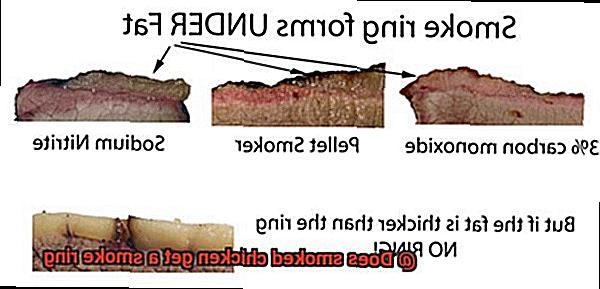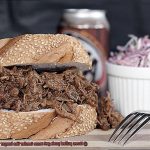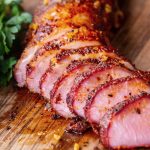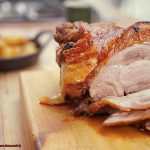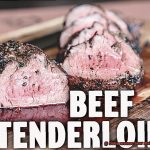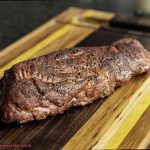Today, we’re embarking on a daring expedition into the realm of smoked chicken. Brace yourselves for a tantalizing journey where science dances with flavor in the most mouthwatering of ways. If you’ve ever found yourself marveling at that elusive smoke ring encircling your succulent bird, pondering how and why this mystical phenomenon occurs, then you’ve stumbled upon the perfect place.
Get ready to have your taste buds tickled and your mind blown as we peel back the layers of smoky secrecy. That smoke ring isn’t just some fancy cosmetic touch—it’s a captivating clue to chemical reactions, expert cooking techniques, and a pinch of barbecue sorcery.
Join me as we unravel the scientific secrets behind smoked chicken’s enigmatic smoke ring, discovering what makes your humble backyard creation resemble a culinary masterpiece on a plate. Be warned: this adventure might leave you itching to fire up that grill and conquer the smoke ring challenge yourself. So buckle up for a wild ride through the realms of smoke, fire, and the irresistible allure of smoked chicken’s legendary smoke ring.
Contents
What is a Smoke Ring?
In the realm of grilling and smoking meats, the term “smoke ring” holds a certain mystique. It is the captivating pinkish-red halo that adorns the outer layer of smoked delicacies like brisket and pork ribs.
But what exactly is a smoke ring, and why does it hold such allure? Join us as we embark on a journey into the intriguing world of smoke rings, revealing their secrets and unraveling their enigma.
The Science Behind the Smoke Ring:
The phenomenon of the smoke ring arises from a captivating chemical reaction between nitrogen dioxide (NO2) and myoglobin, a protein found in meat. When wood or charcoal combusts during the smoking process, it releases an array of gases, including nitrogen dioxide.
This gas then melds with moisture on the surface of the meat, giving birth to nitric oxide (NO). The ensuing magic occurs when nitric oxide encounters myoglobin, leading to the formation of nitric oxide myoglobin, which imparts the distinctive hue to the smoke ring.
Factors Influencing Smoke Ring Formation:
While achieving the perfect smoke ring may seem like an art form, several variables impact its development. These include the type of fuel employed, cooking temperature, and duration within the smoker’s embrace.
The sweet spot for smoke ring creation lies between 225°F and 275°F (107°C and 135°C), where the dance between flavors and textures truly manifests.
Additionally, thicker cuts of meat tend to boast a more pronounced smoke ring due to their extended exposure to the ethereal tendrils of smoke.
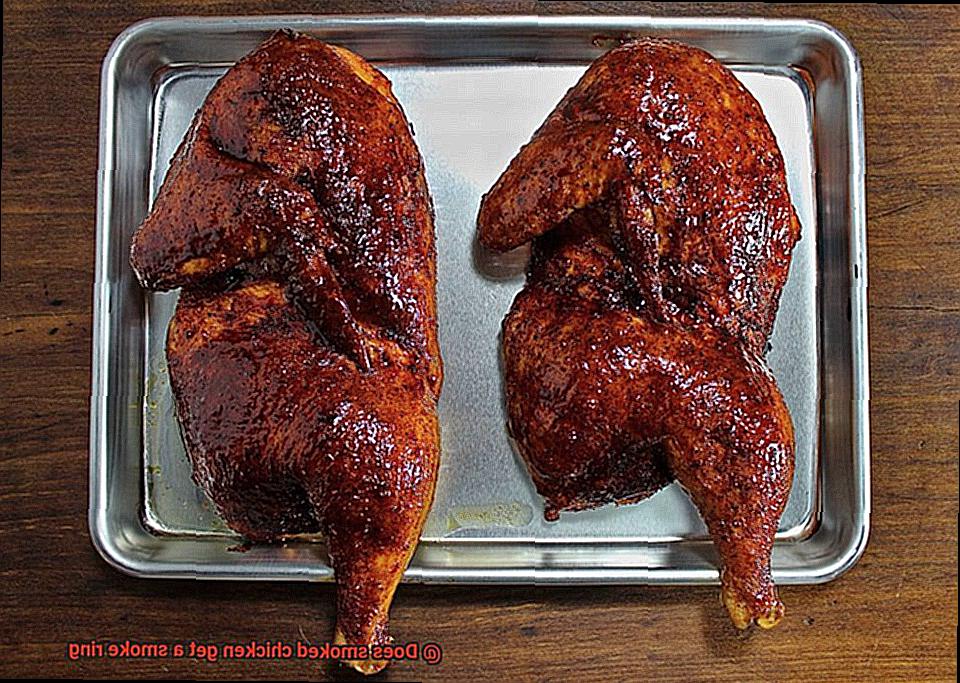
Does Smoked Chicken Possess a Smoke Ring?
When it comes to smoked chicken, we enter slightly trickier terrain. Chicken naturally contains less myoglobin than its beef or pork counterparts, making it less likely to display a visible smoke ring with ease. Moreover, the shorter cooking time of chicken means it has fewer opportunities for the smoke to weave its mesmerizing tapestry and create a smoke ring.
Tips for Enhancing the Smoke Ring on Chicken:
Although smoked chicken may not prominently showcase a smoke ring, fear not, for there are techniques to enhance its formation. One method involves utilizing rubs or marinades infused with ingredients rich in nitrates or nitrites, such as celery powder or pink curing salt. These additives elevate the nitrite content within the meat, providing a boost to smoke ring development.
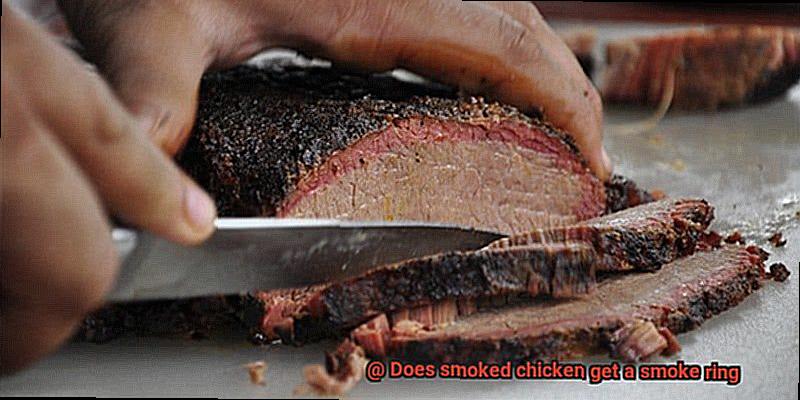
Another technique involves extending the cooking time through low-and-slow smoking at a lower temperature, allowing for prolonged exposure to the ethereal wisps of smoke.
Remember, Smoke Rings Are Not Everything:
While the presence of a smoke ring tantalizes the eyes and is often associated with enhanced flavor and tenderness, it is crucial to remember that it is not the sole arbiter of taste and quality. Even if your smoked chicken lacks a prominent smoke ring, rest assured that it can still be a delectable feast. The smoke imparts its flavors throughout the meat during the cooking process, ensuring a succulent and flavorful experience.
What Causes the Formation of a Smoke Ring?
Today, we embark on a journey into the captivating realm of smoke rings. That mesmerizing pinkish-red layer beneath the surface of perfectly smoked meats has long intrigued and delighted our taste buds. Brace yourselves as we unravel the scientific wonders behind this enigmatic phenomenon and explore whether your beloved smoked chicken can join the illustrious smoke ring club.
The Chemistry Behind Smoke Rings:
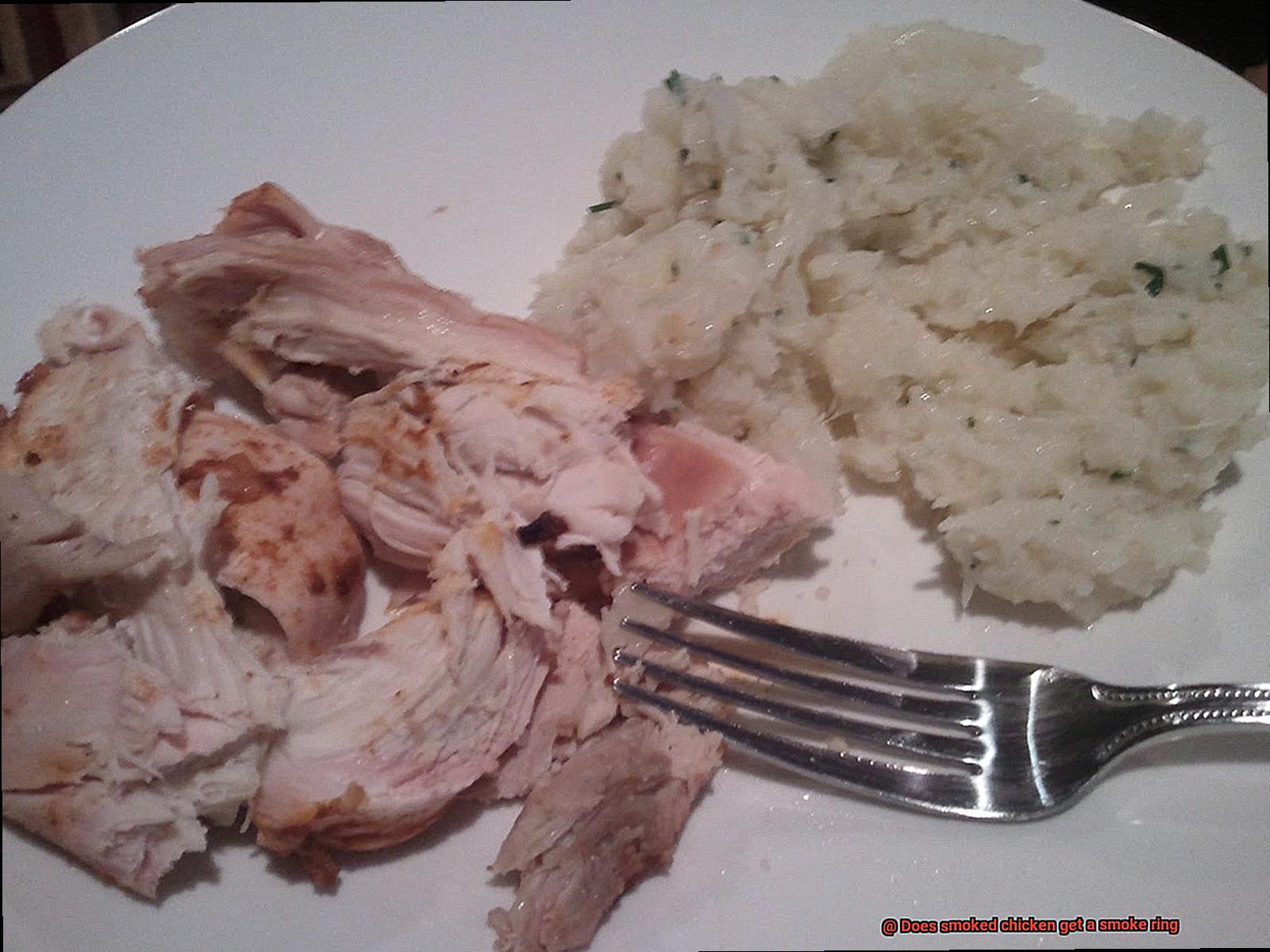
Contrary to popular belief, smoke rings are not solely formed by smoke itself. The true magic lies within a chemical dance between nitrogen dioxide (NO2) in the smoke and myoglobin, a protein found in muscle tissue. As wood or charcoal burns, it releases gases including NO2, which then dissolves into the meat’s surface moisture.
The Magical Transformation:
Once dissolved, NO2 joins forces with myoglobin to create nitric oxide (NO). This NO then undergoes a remarkable metamorphosis, transforming into nitrosylhemochrome—a compound responsible for that alluring pink hue of the smoke ring. Even after cooking, this compound remains intact, proudly showcasing your grilling prowess.
Factors Influencing Smoke Ring Formation:
To achieve an enviable smoke ring, two key factors come into play. Firstly, you need an ample supply of NO2 in the smoke. Incomplete combustion or specific fuel choices can up the ante on NO2 production. Secondly, moisture on the meat’s surface is crucial for NO2 to dissolve and work its magic with myoglobin. A light oil or sauce coating or using a water pan inside the smoker can help maintain this vital moisture balance.
Timing is Everything:
The formation time of a smoke ring varies depending on meat thickness, cooking temperature, and NO2 levels in the smoke. Patience is paramount—it can take anywhere from 30 minutes to several hours for that perfect smoke ring to develop in all its glory.
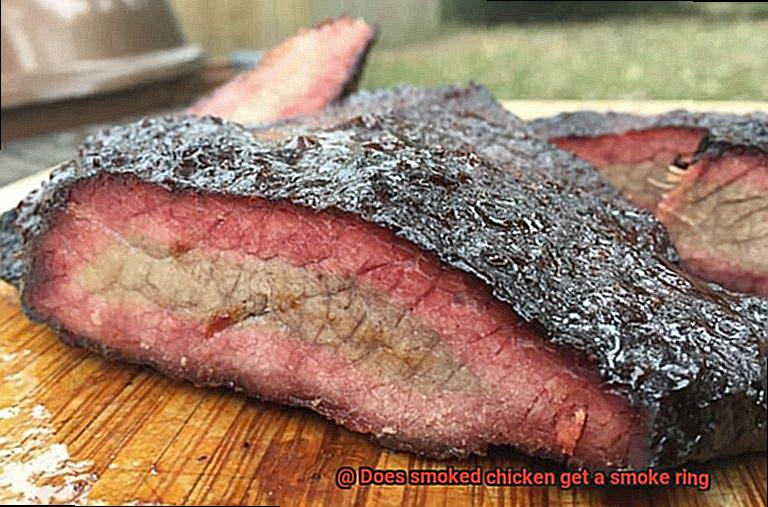
Smoked Chicken: Can it Join the Smoke Ring Club?
While smoked chicken can indeed develop a smoke ring, it may be less pronounced compared to red meats like pork or beef. Chicken has lower myoglobin levels, meaning there’s less protein available for the NO2 reaction. But fret not. Even without a prominent smoke ring, smoked chicken is still bursting with flavor and juiciness, making it a delectable choice for your grilling escapades.
Does Chicken Get a Smoke Ring?
Before we dive into the juicy details, let’s quickly recap what a smoke ring is and how it forms.
Imagine sinking your teeth into a tantalizing bite of perfectly smoked brisket or pork. As you savor the flavor, you notice a mesmerizing pinkish-red layer encircling the edges. That, my friends, is the smoke ring – nature’s way of proclaiming “This meat is deliciously smoky.”
Now, let’s talk chicken. Can our feathered friend join the smoke ring party? The answer isn’t as straightforward as we’d like it to be. While chicken can indeed be smoked, it typically doesn’t develop a prominent smoke ring like beef and pork. But fear not, for we’re about to unravel the mystery.
First off, chicken’s cooking time is considerably shorter compared to hefty cuts like brisket or pork shoulder. The Maillard reaction – that magical chemical process responsible for the smoke ring – needs time to work its wonders. The longer meat is exposed to smoke, the more pronounced the smoke ring becomes. Since chicken cooks relatively quickly, there’s limited time for that beautiful pinkish-red discoloration to form.
Another factor at play is myoglobin – the protein responsible for that enchanting color in smoked meat. Unfortunately for our poultry-loving friends, chicken has less myoglobin than beef or pork. With less of this protein present, the resulting smoke ring will be less pronounced.
Lastly, chicken boasts thinner skin compared to other meats. While this may lead to irresistibly crispy skin, it also acts as a barrier between the smoke and the meat. Consequently, it becomes more challenging for the smoke to deeply penetrate and create a visible smoke ring.
But hey, don’t let the absence of a smoke ring dampen your spirits when smoking chicken. Even without that pinkish-red layer, smoked chicken can still be incredibly flavorful and tender. The smoke infuses the meat with a mouthwatering aroma and taste that will set your taste buds dancing with joy. And let’s not forget the golden and crispy skin that adds a delightful crunch and flavor to the overall experience.
So, my grilling aficionados, the next time you plan to smoke some chicken, focus on achieving succulent and juicy meat rather than fretting about a visible smoke ring. Remember, it’s all about the flavor and tenderness that smoking brings to the table.
Techniques to Enhance the Formation of a Smoke Ring on Chicken
While not as prominent as on beef or pork, a smoke ring on chicken adds a touch of flavor and visual appeal that takes your grilling game to the next level. In this article, we will delve into some proven techniques to enhance the formation of a stunning smoke ring on your grilled chicken.
Choose the Right Wood:
To kickstart the smoke ring formation, opt for hardwoods like oak, hickory, or mesquite. These woods are rich in nitrogen dioxide, a crucial element for creating a smoke ring. Soak the wood chips or chunks in water before adding them to your grill to generate more smoke and improve the chances of a beautiful smoke ring.
Low and Slow:
Take your time when smoking chicken to maintain low and steady temperatures. Aim for a range between 225-250°F (107-121°C) to allow for a prolonged exposure to the smoke. This extended timeframe encourages the chemical reaction between nitrogen dioxide and myoglobin, resulting in a more pronounced and tantalizing smoke ring.
Sweeten the Deal:
Elevate the development of the smoke ring by incorporating a rub with a high sugar content. Consider seasonings that contain brown sugar or maple syrup in your rub. The sugar acts as additional fuel for the chemical reaction, contributing to the formation of a captivating and delectable smoke ring.
Embrace Moisture:
Introduce a water pan into your smoker to create a moist environment. This step aids in generating ample smoke and ensures even distribution onto the chicken’s surface, boosting the likelihood of a vivid smoke ring forming. The presence of moisture in the air plays a vital role in carrying those flavorful smoke particles.
Patience is Key:
After achieving the perfect smoke on your chicken, resist the temptation to dive right in. Allow the chicken to rest for a minimum of 10-15 minutes. This essential resting period allows the smoke ring to set and become more distinct while enabling the juices to redistribute within the meat.
The result? A succulent, moist, and visually striking chicken that is sure to impress.
The Role of Nitrates and Nitrites in Enhancing the Smoke Ring
Creating a beautiful smoke ring on your grilled chicken is the epitome of barbecue mastery. That pinkish hue on the outermost layer not only adds visual appeal but also indicates enhanced flavor and tenderness. The secret behind this coveted smoke ring lies in the use of nitrates and nitrites.
Nitrates and nitrites are chemical compounds that play a crucial role in the curing process of meats, including smoked chicken. These compounds work their magic by converting the myoglobin, a protein responsible for the meat’s red color, into nitric oxide. When exposed to oxygen, nitric oxide reacts to form nitric oxide myoglobin, which gives the smoke ring its signature pink color.
But the benefits of nitrates and nitrites go beyond appearance. These compounds also contribute to the flavor and preservation of smoked chicken. With their antimicrobial properties, they help inhibit the growth of bacteria, extending the shelf life of your smoky creation.
Moreover, nitrates and nitrites play a vital role in preventing oxidation, which can lead to off-flavors and spoilage.
However, it is essential to note that there are concerns about the potential health risks associated with consuming foods containing nitrates and nitrites. Some studies suggest that consuming large quantities or combining them with certain substances may increase the risk of certain types of cancer.
Therefore, moderation is key when enjoying smoked chicken and other cured meats.
To achieve that mouthwatering smoke ring on your grilled chicken, several factors come into play. First and foremost, choose the right wood for smoking. Different woods impart different flavors, so experiment with options like hickory, applewood, or mesquite to find your perfect match.
Maintaining low and slow temperatures is also crucial. This allows the smoke to penetrate the meat slowly, giving it ample time to work its magic and create that beautiful smoke ring.
Don’t forget to sweeten the deal with a high-sugar rub. The sugar caramelizes during the smoking process, adding a touch of sweetness to complement the smoky flavor and enhance the color of the smoke ring.
Embrace moisture by using a water pan in your grill. This helps create a humid environment, keeping your chicken moist and aiding in the formation of the smoke ring.
Lastly, patience is key. Creating a smoke ring takes time, so resist the temptation to rush the process. Sit back, relax, and let that delicious smoky aroma fill the air while your smoke ring sets and creates a succulent masterpiece.
Low-and-Slow Smoking for Maximum Flavor and Tenderness
When it comes to grilling, there are countless techniques to elevate the taste and texture of your meat. However, one method stands out for its ability to create succulent and flavor-packed results: low-and-slow smoking. In this article, we will dive into the myriad benefits of low-and-slow smoking when it comes to maximizing the flavor and tenderness of chicken.
The Art of Slow Cooking:
Low-and-slow smoking involves the patient process of cooking chicken at a low temperature over an extended period. This method allows the alluring flavors from the wood smoke to permeate the meat, creating a delectably rich and smoky taste. Moreover, this unhurried cooking process works wonders in breaking down the collagen and connective tissues within the chicken. As a result, every bite becomes an explosion of tenderness and juiciness, effectively eliminating the dreaded dryness often associated with lean meats like chicken.
Behold the Smoke Ring:
One visual testament to the low-and-slow smoking technique is the mesmerizing smoke ring that forms on the surface of the chicken. While not directly linked to flavor or tenderness, this captivating phenomenon adds an irresistible touch to your culinary masterpiece. The smoke ring is caused by a chemical reaction between nitrogen dioxide in wood smoke and myoglobin, a muscle tissue protein. To enhance its prominence, opt for hardwoods like oak, hickory, or mesquite and maintain a consistently low temperature throughout the smoking process.
Quality Ingredients for Optimal Results:
While low-and-slow smoking is an extraordinary technique on its own, it is crucial to recognize that the quality of ingredients plays a pivotal role in achieving mouthwatering smoked chicken. Begin with fresh and high-quality chicken, preferably organic or free-range, as it serves as a superior flavor foundation for the smoking process. By selecting the finest ingredients, you set the stage for an unforgettable taste experience.
The Significance of the Smoke Ring
Today, we embark on a flavorful journey into the world of smoked meats, where we unravel the significance of that mesmerizing smoke ring that adorns your grilled chicken. Get ready to elevate your taste buds and take your grilling skills to new heights.
Let’s start with the visual allure. The smoke ring is a vibrant pink or reddish hue that forms on the surface of smoked meat, including our beloved chicken. It’s nature’s way of applauding your grilling prowess with a visual high-five. This eye-catching ring adds a burst of color to your plate, making your dish irresistibly appetizing. Prepare for jaws to drop and taste buds to tingle as people marvel at your grilling mastery.
But the smoke ring is not just about aesthetics; it’s also a badge of skill and technique. Achieving a deep and pronounced smoke ring requires meticulous attention to detail and a sprinkle of barbecue magic. It’s all about mastering temperature control, applying the perfect amount of smoke, and patiently allowing the flavors to develop. When you hit the mark, it’s like hitting a grand slam in the grilling universe.
However, here’s the juicy secret: while the smoke ring showcases expertise, it doesn’t guarantee a smoky flavor. The type of wood you use and the duration of the smoking process are also key players in determining the taste profile of your chicken. So, don’t let a less pronounced smoke ring dampen your spirits – it’s just one piece of the tantalizing flavor puzzle.
That being said, many barbecue enthusiasts and competition judges place great importance on the presence and appearance of a smoke ring when assessing the quality of smoked meat. It has become a coveted symbol for pitmasters who take pride in their craft. Let’s face it, who wouldn’t want to flaunt their grilling skills with a breathtaking smoke ring?
My fellow grill masters, the smoke ring may not hold all the flavor power, but it carries significance in terms of aesthetics and stands as a testament to your skill and technique. It’s like a secret handshake among pitmasters – a sign that you’ve unlocked the art of smoking meats.
5x89qBor03U” >
Conclusion
In conclusion, smoked chicken does indeed develop a smoke ring.
This mesmerizing phenomenon occurs when the meat is exposed to the magical dance of smoke and heat in the smoky chamber. As the flavorful smoke infiltrates every inch of the chicken’s succulent flesh, it leaves behind an enchanting mark—a beautiful pinkish ring that captivates both the eyes and taste buds.
The smoke ring is not just a visual delight; it signifies that the chicken has been lovingly embraced by the smoky embrace, resulting in a tender and delectable masterpiece.

